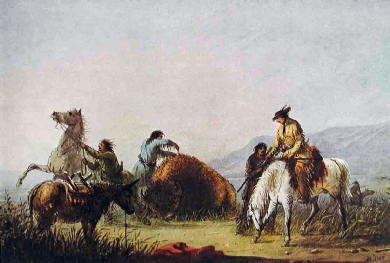Subject Guide

Mountain West
Malachite’s Big Hole
Butchering a Buffalo:
"The process of butchering was a new development of that most useful science. The carcass was first turned upon the belly, and braced to a position by its distended legs. The operator then commenced his labors by gathering the long hair of the "boss" and severing a piece obliquely at the junction of the neck and shoulders, -then parting the hide from neck to rump, a few passes of his ready knife laid bare the sides, -next paring away the loose skin and preparing a hold, with one hand he pulled the shoulder towards him and with the other severed it from the body; -cutting aslant the uprights of the spina dorsi and "hump ribs," along the lateral to the curve, and parting the "fleece" from the tough flesh at that point he deposited it upon a clean grass-spot.
